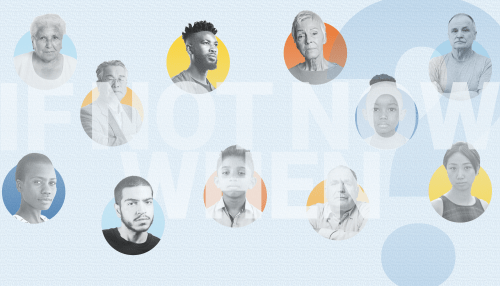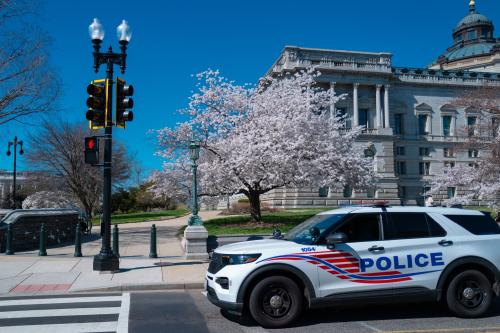The intersection of race and class in America is complex. As we argue in our New Contract with the Middle Class, the terms “middle class” or “working class” are often used as racially-coded, exclusionary terms, with an implicit prefix: white.
It is vitally important, then, to think about both race and class, and the way these two dimensions of inequality interact (we’d add gender too, but that’s for another day). And it is important to get the facts straight, too: the middle class, by our definition, is highly racially diverse – and rapidly becoming more so.
A policy agenda to help the middle class, then, is one to help Americans of all races.
Who is middle class?
There are myriad definitions of the middle class based on cash, credentials, or culture. Even if we focus just on income, there are at least a dozen definitions. In the work of the Future of the Middle Class Initiative, we define the middle class as the middle 60 percent of the income distribution.
For the analysis here, we further restrict our definition to individuals aged 25-54, what economists often call “prime age.” We do this as a crude control for dynamics around age and income – specifically as these dynamics differ between racial groups.[1]
American middle class is now far more diverse
Below we show the racial composition of the middle class in 1979 compared to 2019. Information on race is somewhat limited in earlier years of the Current Population Survey. For example, “Asian or Pacific Islander” was not an option until 1988. In order to compare trends over time, then, we are restricted to the categorization of earlier survey years.
Four decades ago, the vast majority of the middle class was white. In 1979, the middle class was 84 percent white, nine percent Black, five percent Hispanic, and two percent “other.” Over time, the middle class has become much more race–plural. In 2019, the middle class was 59 percent white, 12 percent Black, 18 percent Hispanic, and ten percent “other.”
Diversity of the middle class broadly matches diversity of the country
A major reason why the American middle class has become more diverse over time is because the country has too. Below we compare the racial composition of the middle class with the full income distribution in 2019. White Americans are slightly over-represented in the middle class at 59 percent compared to being 57 percent of the population. Black Americans make up 12 percent of the middle class and 13 percent of the population. Eighteen percent of the middle class identifies as Hispanic compared to 19 percent of the population. Asian Americans comprise seven percent of the middle class and seven percent of the population.
Differences within the middle class remain
While the composition of the middle class broadly reflects the diversity of the country, there is variation within the middle class, however. Below we break the income distribution into five equal buckets, or quintiles. Recall that our definition of the middle class is the middle 60 percent of the income distribution, so the middle class is represented by the second, middle, and fourth quintiles.
White Americans comprise almost two-thirds of the fourth quintile compared to 59 percent and 51 percent for the middle and second quintiles, respectively. Black and Hispanic Americans have the opposite gradient. Black Americans account for about nine percent of the fourth quintile, twelve percent of the middle quintile, and 15 percent of the second quintile. This phenomenon is even more pronounced for Hispanic Americans. Thirteen percent of the fourth quintile is comprised of Hispanic Americans, compared to 18 percent of the middle quintile and 24 percent of the second quintile. Asian Americans make up eight percent of the fourth quintile, six percent of the middle quintile, and six percent of the second quintile.
Far more to do to ensure equal opportunity
Large racial gaps remain in the United States, including disturbing differences in economic mobility and wealth between Black and white Americans. The American middle class – now comprising high proportions of Black and Hispanic Americans has also experienced a time squeeze and slower income growth.
Here, we highlight that the racial composition of the middle class has changed dramatically over time – 40 percent of the middle class is not white. Middle-class problems do not just impact white Americans, but a diverse set of Americans. Conversely, systemic barriers to opportunity experienced by marginalized groups are middle-class issues too. Pursuing racial justice and improving the well-being of the American middle class are now, more than ever, complementary goals for public policy.
[1] Income concept is pre-tax household money income on a size-adjusted basis (using the square root method). As stated above, analysis is restricted to adults aged 25-54, though household income may include income from household members younger than 25 or older than 54. For 2019, the range for middle class on a size-adjusted basis is about $26,400 to $96,700. That is equivalent a range of about $37,300 to $136,800 for a household or two. For a household of three, that is equivalent to about $45,700 to $167,500.
The Brookings Institution is committed to quality, independence, and impact.
We are supported by a diverse array of funders. In line with our values and policies, each Brookings publication represents the sole views of its author(s).









Commentary
The middle class is already racially diverse
October 30, 2020